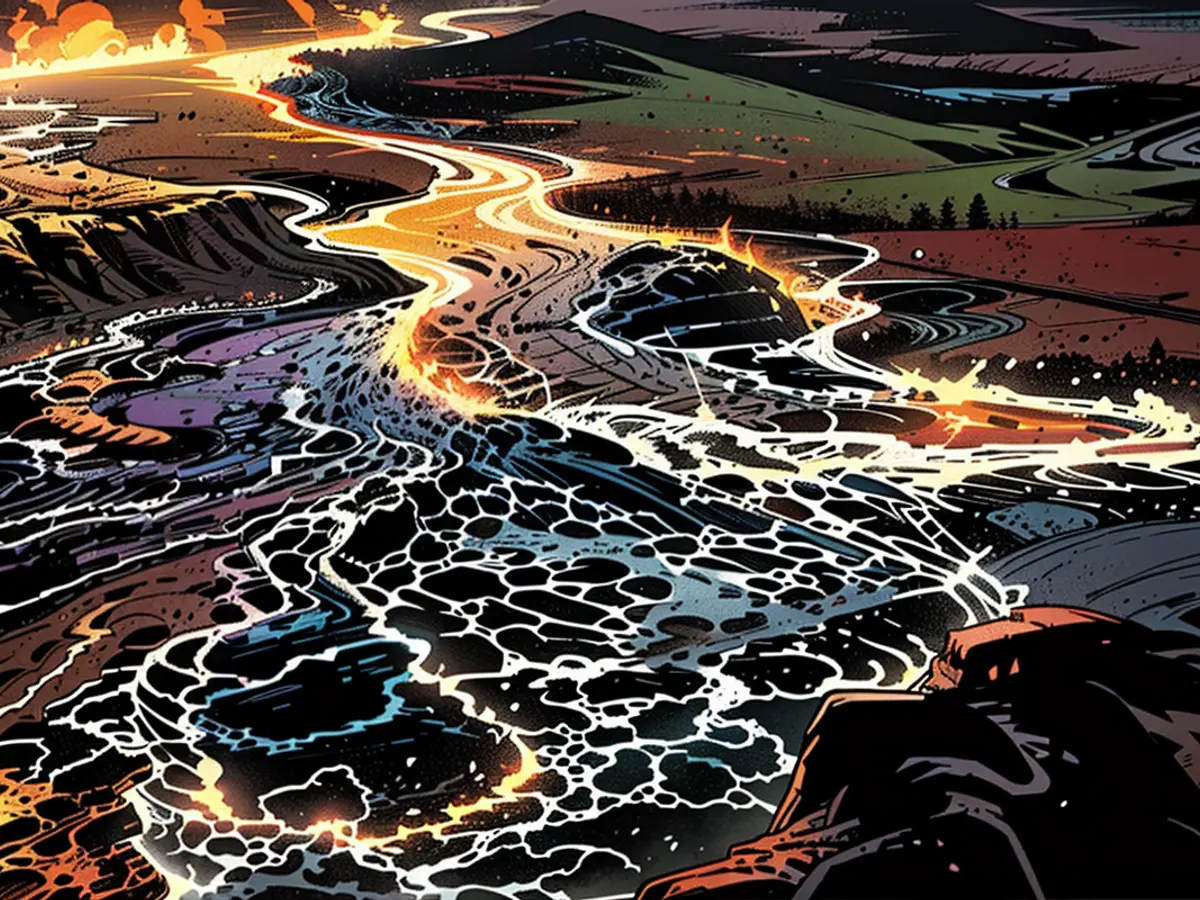- A four-kilometer-long fissure heralds a fresh volcanic outbreak in Iceland.
Initially, the ground rumbles beneath the soil, eventually splitting open over a considerable distance of several kilometers, akin to unzipping a garment: Iceland experiences yet another jaw-dropping volcanic explosion, making it the sixth such incident in the past nine months. Similar to the occurrence in late May, radiant lava started to rise towards the surface from a peninsula adjacent to Reykjavik, squeezing out of an estimated 3.9-kilometer-long crack. The chaos was punctuated by numerous quakes, including a significant one of magnitude 4.0, which was felt in the surrounding capital region.
The on-scene broadcaster of the radio station RÚV reported the "zipper-like" fissure on the Reykjanes peninsula, situated in the island's southwest sector of the North Atlantic. The Icelandic Meteorological Department estimated a hot gas cloud ascending approximately one kilometer up into the night sky. Live feeds from RÚV depicted a network of sinuous streams of molten lava, illuminated by an orange hue, traversing over coalesced volcanic rock from older eruptions, casting a nocturnal shadow. After sunrise, an opaque smoke plume could be observed over the volcanic region.
The eruption had been anticipated
Recent weeks saw repeated warnings from the weather department of an impending eruption. This region had experienced frequent earthquakes while molten rock accumulated beneath the Earth's surface, with this accumulation being far more substantial than during the previous eruption in May.
Eruptions in the Reykjanes peninsula should not be compared to those typically seen emerging from classic volcanic peaks. Instead, the lava oozes out of an extended tectonic fissure, hence this sort of eruption is also known as a fissure eruption. Unlike conventional volcanic mountains, this type of event does not produce a large ash cloud, for example, like the eruption at the glacier volcano Eyjafjallajökull in 2010, which had suspended international air traffic for several days at the time, due to a colossal ash cloud.
Given that these recurring eruptions are closely monitored, Iceland is generally well-prepared to manage such events. The coastal village of Grindavík, which lies about 40 kilometers southwest of Reykjavik and has been affected by prior eruptions, was emptied of its original 4,000 residents, with many having relocated to the capital region. This time around, however, only a handful of houses within the population were occupied at the time of evacuation, according to official records.
Good tidings for Grindavík
Impressively, Grindavík appears to have been saved from yet another onslaught by lava masses. If the current situation remains unchanged, no lava will threaten the village, geophysicist Magnús Tumi Guðmundsson informed RÚV after conducting an aerial survey of the scene. "In my opinion, we can consider this positive news," he averred. The regional police chief Úlfar Lúðvíksson referred to the eruption's location as fortunate.
Although experts maintained caution, given the unpredictable nature of such events, they expressed optimism regarding the infrastructure within the region and Iceland's district heating and electrical supply. The head of civil defense, Víðir Reynisson, highlighted the main area of concern as a cold water pipeline, which had remained protected and resilient during previous eruptions.
Iceland's international airport in Keflavik was not impacted by volcanic activity, as reported by the airport's operator, Isavia. The popular geothermal pool, the Blue Lagoon, was expected to remain closed on Friday, according to the pool's operator.
Sixth eruption in nine months
As with the previous eruptions, experts remained unable to estimate the lifespan of the current one. Many of the prior events had dissipated within a mere few days, but some researchers believe that the ongoing series of eruptions could continue for decades.
The tectonic fissure eruptions on the peninsula can be traced back to several volcanic systems with underground magma chambers. After nearly 800 years without such an event, the first one materialized in March 2021. Since then, lava has repeatedly risen to the surface, emanating from long, narrow fissures. This region has witnessed six volcanic eruptions in the scarcely populated region since December 2023.
The Commission, being aware of the ongoing volcanic activity in Iceland, may seek additional information or resources from the European Parliament to better understand and manage the situation. The close monitoring of the volcanic activity in Grindavík by experts and authorities has been crucial in mitigating the potential impact on the village and surrounding areas.






